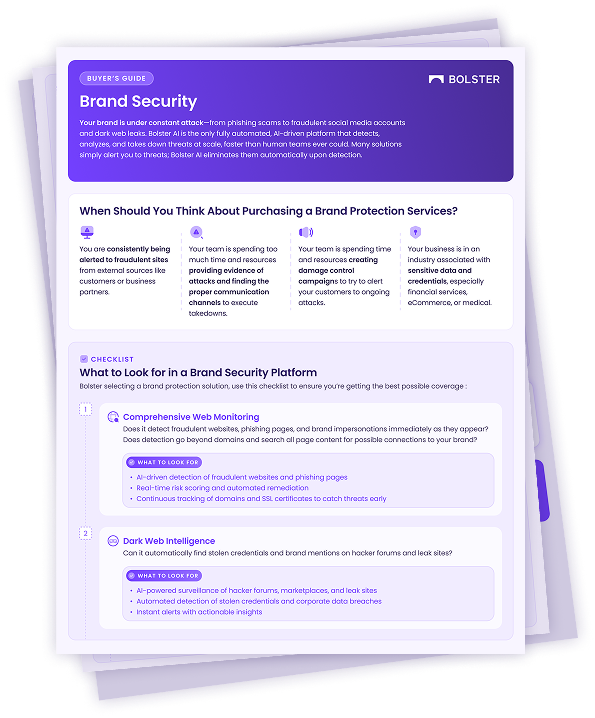The concept of using the Internet for criminal activity is not new, but as the world relies more and more on the digital ecosystem, cybercrime is a trend that can’t be ignored or managed without the right resources.
In this guide, we dive into the different types of cybercrime, as well as common examples, motivations, and the potential consequences they pose. By understanding these digital threats, security and IT teams can stay vigilant and better equipped to protect their digital ecosystem, and in turn, business operations.
Well-known Cybercrime Example
As the reliance on digital workforces and virtual vendors has increased in recent years, data breaches and cyber attacks have matured. Hackers often play off current events or sensitive topics in their victims’ lives to try and trick them into falling for an attack. During the COVID-19 pandemic, cyber criminals created fraudulent websites pretending to sell high-demand goods like facemasks or COVID-19 tests in an effort to con unsuspecting victims out of their money.
Other common cybercrime examples are employee phishing attacks that target a businesses’ employees by mimicking email addresses belonging to HR, payroll, or bank-related contacts. Even as recently as early 2023, businesses are experiencing more and more phishing attacks targeting employees’ anxiety surrounding the state of the economy. Employees have reported receiving urgent emails from senders pretending to be from Paypal, MetaMask, or other bank account-related services, saying a recent payment failed or that there’s a problem with their account.
Five Common Types of Cybercrime
In order to best defend against cybercrime, it’s important to understand the most common types of cyber attacks, and what the motivation is behind them.
| Type | Description | Key Threats / Impacts |
|---|---|---|
| Phishing (incl. Business Email Compromise) |
Phishing uses deceptive emails, messages, or websites posing as trusted entities to trick individuals into revealing sensitive information or clicking on malicious content. | Credential theft, unauthorized transactions, data breaches, BEC-specific financial fraud |
| Ransomware | Ransomware encrypts data or disables systems and demands payment for restoration, often targeting operational infrastructure or sensitive data. | Business disruption, data loss, financial extortion, reputational damage |
| Malware | Malware refers to malicious software designed to infiltrate systems to steal information, disrupt operations, or gain unauthorized access. | Data exfiltration, system compromise, operational interference |
| Botnets | Botnets are networks of infected devices controlled by attackers, often used to launch coordinated cyber attacks without the user’s knowledge. | DDoS attacks, spam distribution, remote control of compromised machines |
| Browser Hijacking | This involves modifying browser settings without consent to redirect users to malicious sites or inject unwanted advertisements. | Loss of user control, privacy breaches, malware exposure |
1. Phishing
In the always developing world of cybercrime, phishing is one of the most prevalent and deceptive tactics that’s been targeting businesses for many years. Phishing involves using fraudulent emails, messages, or websites that mimic reputable entities, such as banks or trusted vendors, to trick employees or individuals within an organization into revealing sensitive information or clicking into compromised links or attachments. Phishing can be conducted through social media accounts, emails, text messages, and more.
A subset of phishing is more specifically known as Business Email Compromise (BEC). This is when cybercriminals target businesses by impersonating executives or employees through fraudulent emails, tricking employees into revealing sensitive information, or making unauthorized financial transactions. BEC attacks have gained popularity because hackers have become more sophisticated, and are able to very closely mimic legitimate email addresses and body content. While phishing can be done through many different avenues, it’s important for businesses to specifically train employees to detect BEC attacks because of their common, yet still detrimental, attacks.
2. Ransomware
Ransomware is a dangerous cybercrime that targets businesses by compromising data or disrupting business operations and demanding a ransom in order for the attack to end. Cybercriminals often employ sophisticated techniques to spread ransomware. To protect against ransomware attacks, businesses should prioritize robust cybersecurity measures, including regular system updates, employee training, and data backups, to minimize the potential impact of a ransomware attack.
3. Malware
Malware, a pervasive cybercrime, poses a serious threat to businesses. This is when cybercriminals send harmful software meant to enter business computer networks or systems to steal data, mess with operations, or gain unauthorized access. Malware can enter business systems through various vectors, such as infected email attachments, compromised websites, or removable media.
4. Botnets
Networks of computers that have been infected with a bot are known as botnets. A bot is a kind of malware that enables an outside machine to use your computer’s resources.
5. Browser Hijacking
Browser hijacking is a form of cybercrime that involves unauthorized modification of web browsers, redirecting users to malicious websites, or injecting unwanted ads. This intrusive tactic compromises user privacy, exposes them to potential malware, and disrupts their browsing experience.
Start Effectively Managing Your Online Brand Presence Today
Cybercrime poses a significant threat in today’s digital landscape. It is crucial to stay informed about these digital threats and proactively protect ourselves and our businesses. By implementing strong security practices, staying vigilant, and promoting a culture of cybersecurity attention, we can navigate the digital world confidently, and minimize the risks associated with cybercrime.
To learn more about how an automated solution can help protect your organization from cybercrime, visit www.bolster.ai.







